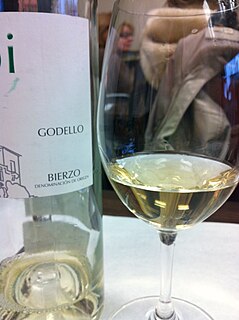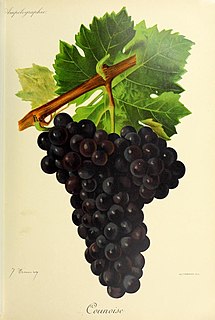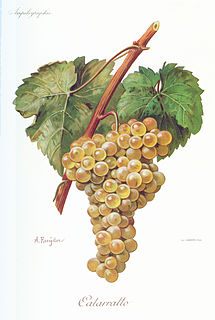Related Research Articles

Mauzac or Mauzac blanc a white variety of grape used for wine, of the species Vitis vinifera. It is mainly grown in the Gaillac and Limoux regions in the southwest of France. Total French plantations of Mauzac stood at 3,200 hectares in the year 2000.

Mencía, known as Jaen in Portugal, is a Spanish grape variety primarily found in the northwestern part of the country. It is planted on over 9,100 hectares, and it is primarily found in the Bierzo, Ribeira Sacra, Valdeorras and Monterrei regions.

Godello is a white variety of wine grape grown in northwestern Spain, in particular in Galicia. The Gouveio found in northern Portugal is thought to be the same grape variety.

Counoise is a dark-skinned wine grape grown primarily in the Rhône valley region of France. Counoise is also grown in California and Washington. Counoise adds a peppery note and good acidity to a blended red wine, but does not have much depth of colour or tannin. There were 638 hectares of Counoise in France in 2000.

Grolleau or Grolleau noir is a red French wine grape variety that is grown primarily in the Loire Valley of France. The name is derived from the French word grolle, meaning "crow" and is said to reflect the deep black berries of the Grolleau vine. The grape is most commonly made into rosé wine, particularly in the Anjou region. Grolleau wines tend to low alcohol content and relatively high acidity.

Picardan or Picardan blanc is a white wine grape which is one of 13 permitted blending grapes within the Châteauneuf-du-Pape AOC in Rhône wine region in France, although very little planted. The Vitis International Variety Catalogue previously listed Oeillade blanche as the primary name of the variety, but now identifies Araignan as the primary name. However, since the variety is practically unknown for any other use than the Châteauneuf-du-Pape blend, it most commonly goes under the name used for it in that appellation.
Courbu is the name of three different, but related varieties of wine grapes primarily found in South West France. All are Vitis vinifera grapes. The name Courbu, without suffix, can refer to both Petit Courbu and Courbu blanc, and not all sources differ between the two.

Catarratto is a white Italian wine grape planted primarily in Sicily where it is the most widely planted grape. Overproduction of Catarratto was a substantial contributor to the perceived European wine lake problem in the mid 2000s. Catarratto can make full bodied wines with lemon notes. In the Etna DOC, the grape is often blended with Minella bianca and Carricante.

Cayetana blanca, also known as Cayetana or Jaén, is a white Spanish wine grape. It is grown mainly in the south of Spain, especially in Extremadura and in the Jerez region where it is distilled for use in brandy production.
Chasan is a white French wine grape variety grown primarily in the Languedoc wine region. According to the Vitis International Variety Catalogue, the variety is a crossing of Listan and Pinot. However, some sources describe the grape as a crossing between Listan and Chardonnay. All sources agree, however, that the variety was created in 1958 by Paul Truel at the Institut National de la Recherche Agronomique (INRA) - Unité Expérimentale du Domaine de Vassal & Montpellier SupAgro. One possible source for the confusion of the grapes parentage is that a common synonym of several clones of Chardonnay are sometimes listed as Pinot Chardonnay and Chardonnay, itself, was a crossing of Pinot and the obscure French wine grape Gouais blanc.
Completer or Malanstraube is a white Swiss wine grape variety grown primarily in eastern Switzerland around Graubünden. The Completer vine was once domesticated but has now become mostly feral though some Swiss winemakers will make limited quantities of wine harvested from the wild vines. Wine produced from Completer tends to be very full bodied and aromatic.
Flora is the name of two unrelated varieties of grape, one white and one red, both of United States origin.
Humagne Blanche or Humagne is a white Swiss wine grape planted primarily in the Valais region. The total Swiss plantations of the variety in 2009 stood at 30 hectares.

Loureira, Loureiro or Loureiro Blanco is a white wine grape cultivated in the northwest of the Iberian Peninsula. This includes Galicia, Spain and Minho, Portugal. In the latter, it is notably cultivated along the Lima River, a sub-region of Vinho Verde.
Limnio (LIM-nee-oh) is a red Greek wine grape variety that is indigenous to the Greek island of Lemnos. The grape has had a long history of wine production that may extend back to Ancient Greece with wine historians widely believing it was the grape variety, Lemnia, that was described by Aristotle as producing the famous red Lemnian wine. According to wine expert Oz Clarke, Limnio is "One of Greece's most important red vines."
Gamaret is a variety of red wine grape. It was created by André Jaquinet at Station Fédérale de Recherches en Production Végétale de Changins in 1970 by crossing Gamay and Reichensteiner. Gamaret was developed for cultivation in French Switzerland, and is a full sibling of Garanoir, which was intended for the German part of the country.
Alicante Ganzin is a red French wine grape variety. Unlike most Vitis vinifera wine grapes, Alicante Ganzin is a teinturier with dark flesh that produces red juice. Most varieties used to produce red wine, such as Cabernet Sauvignon, Syrah, etc., have clear color flesh and juice with the wine receiving its color through a maceration process where the color seeps out of the grape skins for as long as they are in contact with the juice. Alicante Ganzin can thus produce light red and rose colored wine without maceration. It is believed that Alicante Ganzin is often described as the progenitor of all French teinturier grapes.

Olmo grapes are wine and table grape varieties produced by University of California, Davis viticulturist Dr. Harold Olmo. Over the course of his nearly 50-year career, Dr. Olmo bred a wide variety of both grapes by means of both crossing varieties from the same species or creating hybrid grapes from cultivars of different Vitis species.
Taminga is white Australian wine grape variety that was developed in the late 20th century by viticulturalist and grape breeder Alan J. Antcliff at CSIRO. It is a cross of a previously created crossing Merbein 29-56 and the Vitis vinifera variety Traminer Rot (Gewürztraminer) Like Tarrango, a 1960s crossing between Touriga Nacional and Sultana, Taminga was bred to maintain high acidity levels while growing in hot Australian vinyards. Early results from Taminga show that it can ripen consistently in different vineyard location and produce wines that wine expert Jancis Robinson describes as "commercially acceptable.
Doradilla is a variety of white wine grape originating in Málaga, southern Spain. It is a distinct variety from Doradillo.
References
- ↑ J. Robinson Jancis Robinson's Wine Course Third Edition pg 109 Abbeville Press 2003 ISBN 0-7892-0883-0
- ↑ Vitis International Variety Catalogue: Doradillo Archived 2012-04-05 at the Wayback Machine , accessed on November 13, 2009
- ↑ Vitis International Variety Catalogue: Jaen Blanco Archived 2012-04-05 at the Wayback Machine , accessed on November 13, 2009
- ↑ Vitis International Variety Catalogue: Doradilla Archived 2012-04-05 at the Wayback Machine , accessed on November 13, 2009